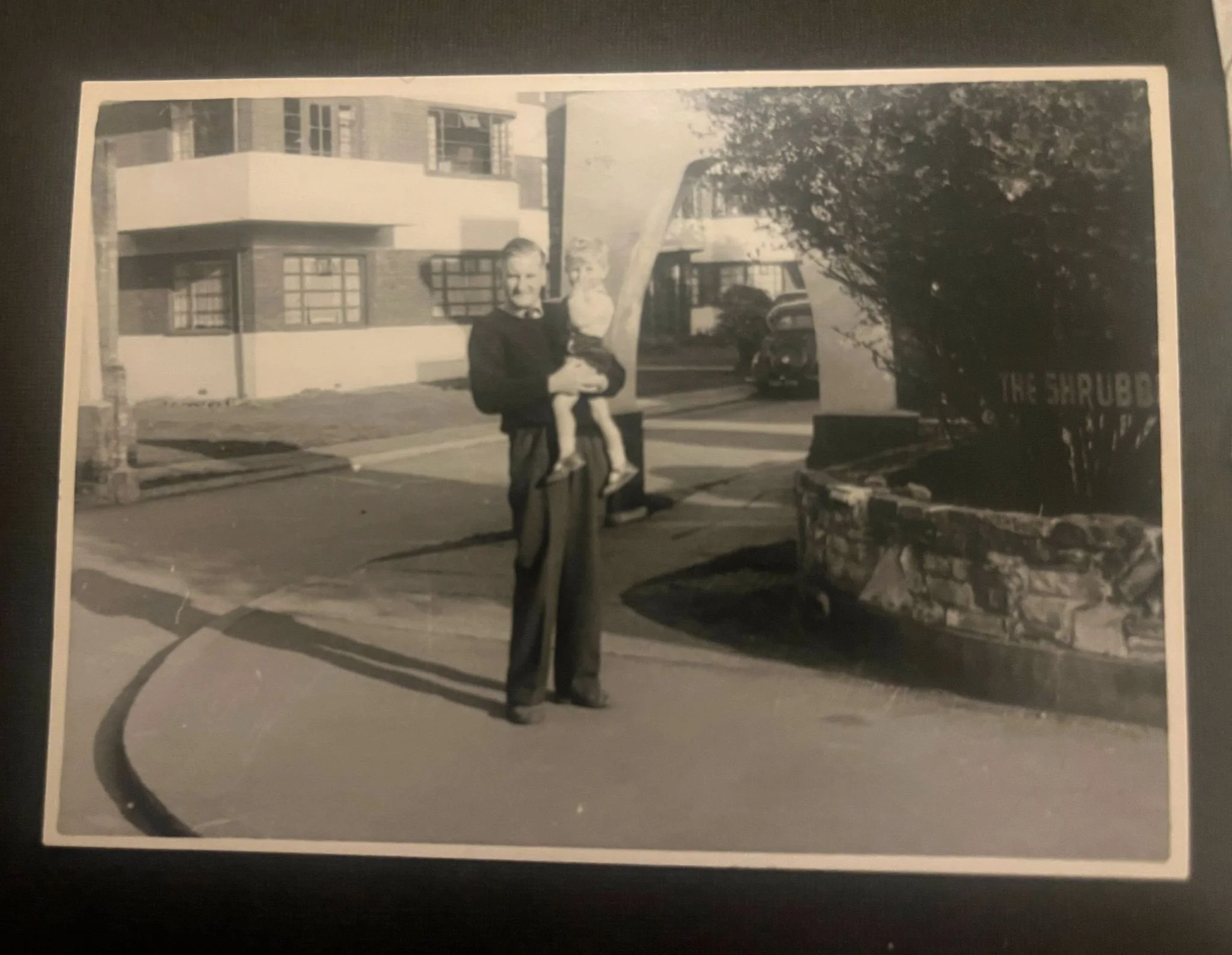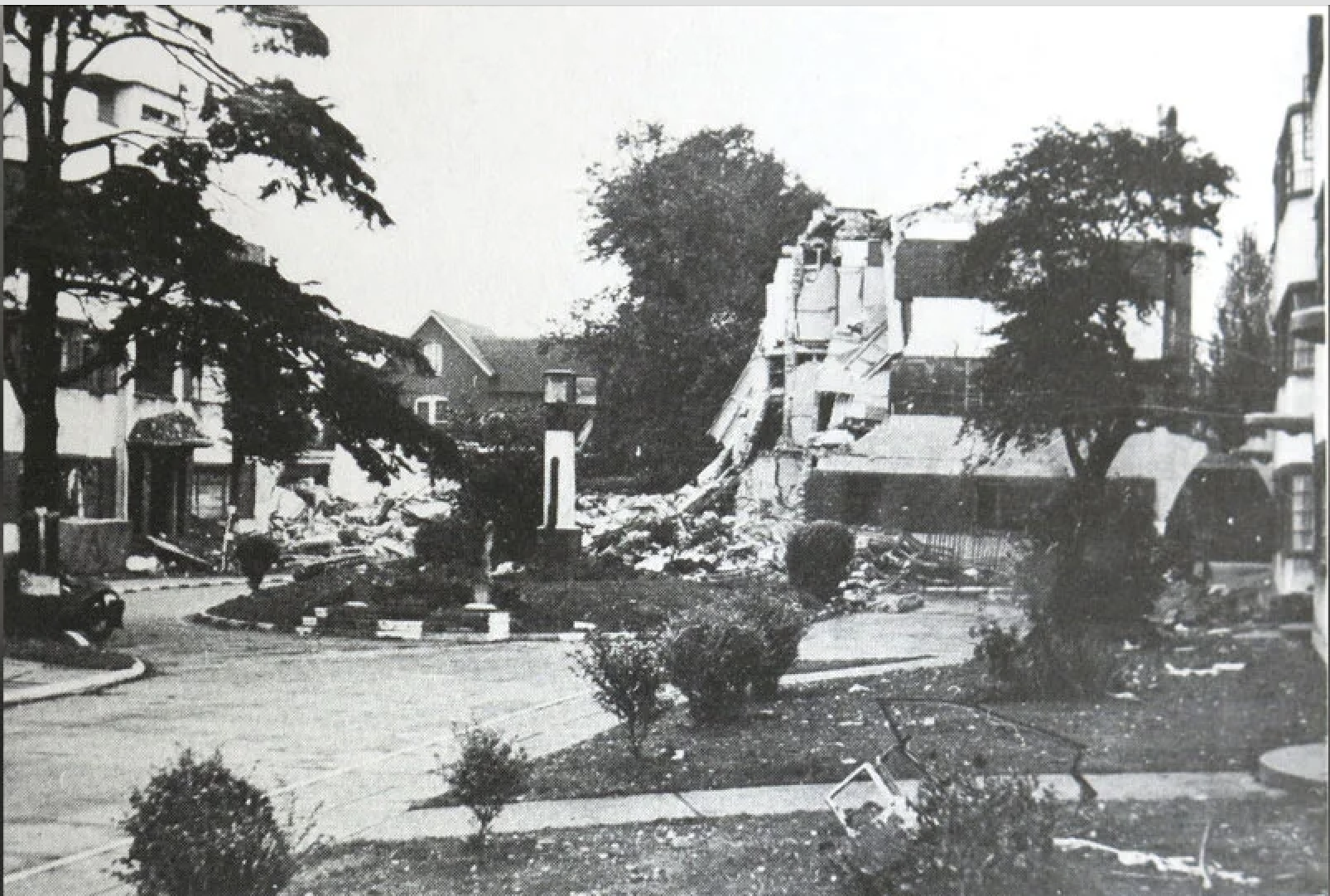History
Luxury Flats under construction in Wanstead, north-east London, 13th March 1935. Workers are laying soundproof flooring in the building, which required a new bye-law to be drawn up before it could be built’ (Photo by Norman Smith/Fox Photos/Hulton Archive/Getty Images)
Current resident Alex Philpott’s father and grandfather circa 1945
A Shrubbery dog circa 1940
The Shrubbery is a Grade II listed site. The National Heritage List for England has this verdict on it:
Summary of Importance: The Shrubbery is an attractive group of three apartment blocks of circa 1935 by Cockett, Henderson & Gillow Ltd for the North-East London Property Company Ltd. The exteriors and interior spaces draw on Art Deco style and Moderne streamlining in their design and are thoughtfully conceived. Although some flats have been subject to alteration, the plan-form is largely intact and there are surviving examples of high quality interiors with notable detailing. The Shrubbery is of special interest as an impressive and thoughtful example of an inter-war apartment block development in a modern style.
The English Heritage Listing
Date first listed: 24 November 2006
List entry number: 1391815
Grade: II “GV II [Group Value Grade II] Apartment blocks circa 1935 by Cockett, Henderson & Gillow Ltd for the North-East London Property Company Ltd, in a moderne and Art Deco inspired style.
Materials: Red brick with significant areas rendered; Crittall steel-framed windows.
Plan: Three, three-storey blocks with roofs flat behind parapets, forming a U-shaped development surrounding a central courtyard garden and drive.
Exteriors: The Shrubbery consists of 42 flats divided between three apartment blocks laid out in a U-shaped plan. Block 1, to the west, houses flats 1 to 18.
Flat 1 was originally conceived as the caretaker’s or warden’s flat and therefore has its own separate entrance.
Block 2 to the south contains flats 19 to 24 and Block 3 to the east accommodates flats 25 to 42. The three blocks are all of three storeys and are of red brick with flat roofs.
There are projecting rendered balconies towards the street frontage, projecting stair wells with raised roof canopies, and curved corner windows to the projecting and receding bays.
The garden and roadside elevations have alternating wide horizontal cream-rendered bands contrasting with exposed brickwork.
Broad green Crittall windows interrupt the brick panels. The rear elevations, away from the courtyard garden, continue to employ devices to add interest such as projecting paired balconies with dwarf walls, although the elevations here are covered in a plain render.
The flat roof is hidden behind a red brick parapet. There are grouped rendered chimney stacks with clay chimney pots continuing the red and cream external colour scheme. Water tanks are housed on the roofs but are hidden from below by raised sections of parapet. Entrance porches have semi-circular canopies echoed by shallow semi-circular steps up to timber-framed glazed double doors flanked by tiled rectangular columns. The exterior is remarkably unaltered and what is particularly noticeable is that the majority of the original window frames survive. A very small number of rear windows and back doors have been altered but given the date of the building the intactness of the fenestration is remarkable.
Interiors: Communal internal spaces employ a similar colour scheme with cream walls and maroon floors. Banisters and dado rails are in a cherry coloured wood to match the door frames and front doors to all the flats. These are solid doors but for a small rectangular glazing panel.
The flats are identified by original wooden numbers affixed to the doors and have diagonal external metal handles. Letterboxes were originally sited adjacent to each flat door through the flat wall and were metal framed and oriented vertically. Many of these survive although some flats have had modern letterboxes inserted through the doors.
The survival of original internal features is variable throughout the flats some of which have experienced considerable modernisation. However, others exhibit remarkable survival and are virtually complete. Original features include: flooring (both wood block and boards); picture rails and curved window ledges; internal wooden doors with bakelite and metal handles; small wall mounted electric fires with tile surrounds; Art Deco fireplaces with geometric tiling; bathroom suites with their contemporary taps, light fittings, and tiling; and kitchens with in-built cupboards with panelled and glazed doors and a fold-down table.
Flats in Block 1, being the first block to be built, were more elaborate in terms of their internal fittings whereas budgetary constraints impacted on the internal finish of Blocks 2 and 3. Although the general layout and accommodation was similar in most cases (the exceptions being the small number of larger flats) it appears that the detailing differed with a unique repertoire for each flat.
The Shrubbery in 1940 following bomb damage. Photo courtesy local historian Dr Colin Runeckles
Subsidiary Items: The development has an access drive from the north flanked by two free-standing pedestrian arches in an Art Deco style. Two further catenary arches link the three blocks at the south of the site. The central garden area contains a cream and brick stepped lamp column which was restored in the late C20 but appears to be part of the original design.
History: The buildings were designed and built by Cockett, Henderson & Gillow Ltd for the North-East London Property Company Ltd. Cockett, Henderson & Gillow Ltd appears to have been a firm of land and estate agents, auctioneers, surveyors and valuers established in the 1890s. The firm advertised in the Essex Kelly’s Directories for 1933 and 1937 as the ‘principal agents for Wanstead, Woodford, Buckhurst Hill, Loughton, Theydon Bois and Epping districts’. They had offices at 167 High Road, Loughton (Essex), 57 High Street, Wanstead and also in Leyton, Leytonstone and Chingford.
A notice of the intention to build Block 3, The Shrubbery (the eastern block housing flats 25-42), dated 2nd July 1935, and plans for the same dated June 1935 survive. The notice of intention indicates that the plans for Blocks 1 and 2 had already been approved although it is not known when building work commenced. It is also known that further plans for flats 19-24 (Block 2, the south block) were approved on 22nd April 1948 although regrettably the drawings appear to have been lost. However, these plans will relate to the renovation of Block 2 which is known to have experienced bomb damage during the Second World War and was then repaired and rebuilt.
The original layout and dimension of the flats in Block 3 is evident from the plans. These were often mirror images of the adjacent property with a living room, two bedrooms, bathroom and kitchenette all opening off a central hallway. All the living rooms had a fireplace and all kitchens a small larder. The position of the kitchen sinks and their draining boards, as well as some built-in cupboards are also depicted. The exceptions to this layout are the corner flats at the northern end of the block on each of the three floors. These have three, rather than the more standard two, bedrooms and rendered cantilevered balconies with dwarf walls which wrap around the north-west corner of this block. Matching balconies are also found at the north-east corner of Block 1 to create symmetry of composition.
Subsidiary Items: The development has an access drive from the north flanked by two free-standing pedestrian arches in an Art Deco style. Two further catenary arches link the three blocks at the south of the site. The central garden area contains a cream and brick stepped lamp column which was restored in the late C20 but appears to be part of the original design.
History: The buildings were designed and built by Cockett, Henderson & Gillow Ltd for the North-East London Property Company Ltd. Cockett, Henderson & Gillow Ltd appears to have been a firm of land and estate agents, auctioneers, surveyors and valuers established in the 1890s. The firm advertised in the Essex Kelly’s Directories for 1933 and 1937 as the ‘principal agents for Wanstead, Woodford, Buckhurst Hill, Loughton, Theydon Bois and Epping districts’. They had offices at 167 High Road, Loughton (Essex), 57 High Street, Wanstead and also in Leyton, Leytonstone and Chingford.
A notice of the intention to build Block 3, The Shrubbery (the eastern block housing flats 25-42), dated 2nd July 1935, and plans for the same dated June 1935 survive. The notice of intention indicates that the plans for Blocks 1 and 2 had already been approved although it is not known when building work commenced. It is also known that further plans for flats 19-24 (Block 2, the south block) were approved on 22nd April 1948 although regrettably the drawings appear to have been lost. However, these plans will relate to the renovation of Block 2 which is known to have experienced bomb damage during the Second World War and was then repaired and rebuilt.
The original layout and dimension of the flats in Block 3 is evident from the plans. These were often mirror images of the adjacent property with a living room, two bedrooms, bathroom and kitchenette all opening off a central hallway. All the living rooms had a fireplace and all kitchens a small larder. The position of the kitchen sinks and their draining boards, as well as some built-in cupboards are also depicted. The exceptions to this layout are the corner flats at the northern end of the block on each of the three floors. These have three, rather than the more standard two, bedrooms and rendered cantilevered balconies with dwarf walls which wrap around the north-west corner of this block. Matching balconies are also found at the north-east corner of Block 1 to create symmetry of composition.
Location and Context
Temple and Lake at Wanstead Grove 1824 to 1832
Wanstead Grove House 1690
First Edition Ordinance Survey Map showing the Wanstead Grove Conservation Area
boundary
1950 Wanstead Station Art Deco entrance - streamlined / curved corner and cantilevered overhang. Photo by Walter A Curtin, May 1950
The Shrubbery is located within the Wanstead Grove Conservation Area. The Shrubbery is one of five listed buildings in this area, set just behind Wanstead High Street, a street recorded on John Rocque’s 1746 map of London.
The flat is situated on the first floor of the western block (identified as Block 1 in the listing), and occupies the full width of the building’s front end, with elevations on three sides. It faces Grosvenor Road (formerly Grove Road), directly opposite a Grade II listed Gothic Revival church. Block 1 is set back from the street, screened by soft landscaping, mature vegetation, and a low boundary wall with gates. These features limit visibility of the windows from the public realm. The flat’s west elevation faces a high boundary wall, while the east overlooks the private internal courtyard.
The character of the surrounding area remains predominantly residential, as it has since the 19th century. Most foot traffic consists of local residents moving towards the high street and public transport links to the City. Long-established schools, churches, and green spaces continue to contribute the neighbuorhood’s identity.
Wanstead Grove Conservation Area 2024. Map showing designated and non-designated heritage assets within the Conservation Area
British Standard colour code for the Shrubbery Windows (accessed via
The Shrubbery’s management records).
Visual similarity 1895 Perry Croft house, a seminal Arts and Crafts work by eminent architect C F A Voysey.










